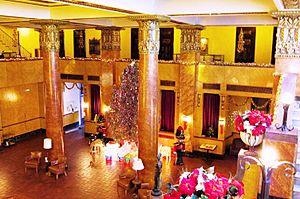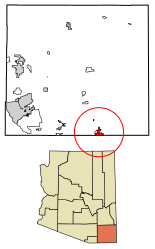Douglas, Arizona facts for kids
Quick facts for kids
Douglas
|
||
|---|---|---|

Lobby of Gadsden Hotel, Douglas
|
||
|
||

Location of Douglas in Cochise County, Arizona
|
||
| Country | United States | |
| State | Arizona | |
| County | Cochise | |
| Incorporated | May 15, 1905 | |
| Government | ||
| • Type | Council-manager | |
| • Body | Douglas City Council | |
| Area | ||
| • Total | 9.98 sq mi (25.85 km2) | |
| • Land | 9.98 sq mi (25.85 km2) | |
| • Water | 0.00 sq mi (0.00 km2) | |
| Elevation | 4,032 ft (1,229 m) | |
| Population
(2020)
|
||
| • Total | 16,534 | |
| • Density | 1,656.88/sq mi (639.72/km2) | |
| Time zone | UTC-7 (MST (no DST)) | |
| ZIP codes |
85607, 85608, 85655
|
|
| Area code | 520 | |
| FIPS code | 04-20050 | |
| GNIS feature ID for the City of Douglas | 2410349 | |
Douglas is a city in Cochise County, Arizona, United States. It is located in the Sulphur Springs Valley. Douglas has a border crossing with Mexico at Agua Prieta. The city has a long history connected to mining.
In 2020, the city's population was 16,531 people.
Contents
History of Douglas
The area where Douglas is now was first settled by the Spanish in the 1700s. A fort called Presidio de San Bernardino was built in 1776. It was located a few miles east of today's Douglas. The United States Army later set up Camp San Bernardino in the late 1800s. In 1910, Camp Douglas was built next to the town.
Douglas was founded as a town for smelting copper. Smelting is a process that takes metal out of ore. The town was built to process copper from nearby Bisbee, Arizona. Douglas is named after a mining leader, Dr. James Douglas. It officially became a city in 1905.
Two copper smelters operated here. The Calumet and Arizona Company Smelter was built in 1902. The Copper Queen smelter worked from 1904 to 1931. Then, the Phelps Dodge Corporation bought the Calumet and Arizona Company. Their smelter became the Douglas Reduction Works. This smelter closed in 1987. Its tall smoke stacks were taken down in 1991.
Geography and Climate
Douglas is located in the southeastern part of Arizona. It is right on the U.S.-Mexico border. Across the border is the city of Agua Prieta, in Sonora, Mexico.
U.S. Route 191 goes north from Douglas for about 69 miles. It connects to Interstate 10 near Willcox. Arizona State Route 80 goes west about 26 miles to Bisbee. It also goes northeast about 80 miles to Interstate 10 in New Mexico.
Douglas's Climate
Douglas has a semi-arid climate. This means it is drier than many places but not a full desert. It is also cooler and gets more rain than a typical desert.
In winter, temperatures are usually in the 60s °F (17–21 °C). Nights often drop below freezing. Sometimes, temperatures can fall below 25 °F.
In summer, daytime highs are usually between 90 and 100 °F (32–38 °C). June is the hottest month, with an average high of 97 °F. Summer nights are warmer, staying in the upper 50s and mid-60s °F (14–18 °C).
June and July usually get about 6 inches or more of rain. This brings the yearly average rainfall to about 14 inches.
The hottest temperature ever recorded in Douglas was 111 °F in July 1905. The coldest was −7 °F in January 1913.
| Climate data for Douglas Bisbee Airport, Arizona | |||||||||||||
|---|---|---|---|---|---|---|---|---|---|---|---|---|---|
| Month | Jan | Feb | Mar | Apr | May | Jun | Jul | Aug | Sep | Oct | Nov | Dec | Year |
| Record high °F (°C) | 82 (28) |
86 (30) |
92 (33) |
99 (37) |
103 (39) |
110 (43) |
109 (43) |
103 (39) |
102 (39) |
95 (35) |
87 (31) |
84 (29) |
110 (43) |
| Mean daily maximum °F (°C) | 62.2 (16.8) |
66.3 (19.1) |
71.4 (21.9) |
78.7 (25.9) |
86.3 (30.2) |
95.1 (35.1) |
93.5 (34.2) |
91.3 (32.9) |
88.4 (31.3) |
80.1 (26.7) |
69.8 (21.0) |
62.4 (16.9) |
78.8 (26.0) |
| Mean daily minimum °F (°C) | 29.4 (−1.4) |
32.1 (0.1) |
36.4 (2.4) |
41.9 (5.5) |
50.2 (10.1) |
59.2 (15.1) |
64.4 (18.0) |
63.3 (17.4) |
58.5 (14.7) |
47.1 (8.4) |
35.2 (1.8) |
29.4 (−1.4) |
45.6 (7.6) |
| Record low °F (°C) | 6 (−14) |
10 (−12) |
13 (−11) |
21 (−6) |
29 (−2) |
40 (4) |
55 (13) |
52 (11) |
36 (2) |
19 (−7) |
5 (−15) |
−4 (−20) |
−4 (−20) |
| Average precipitation inches (mm) | 0.75 (19) |
0.64 (16) |
0.46 (12) |
0.20 (5.1) |
0.33 (8.4) |
0.63 (16) |
3.14 (80) |
2.88 (73) |
1.64 (42) |
1.30 (33) |
0.74 (19) |
1.06 (27) |
13.77 (350.5) |
| Average snowfall inches (cm) | 0.2 (0.51) |
0.1 (0.25) |
0.1 (0.25) |
0 (0) |
0 (0) |
0 (0) |
0 (0) |
0 (0) |
0 (0) |
0 (0) |
0.1 (0.25) |
0.3 (0.76) |
0.8 (2.02) |
| Average precipitation days (≥ 0.01 in) | 5.0 | 4.3 | 3.6 | 1.6 | 2.0 | 3.4 | 13.4 | 11.5 | 6.3 | 4.5 | 3.2 | 4.4 | 63.2 |
| Average snowy days (≥ 0.1 in) | 0.3 | 0.2 | 0.1 | 0 | 0 | 0 | 0 | 0 | 0 | 0 | 0.1 | 0.3 | 1 |
| Source: NOAA | |||||||||||||
People in Douglas
| Historical population | |||
|---|---|---|---|
| Census | Pop. | %± | |
| 1910 | 6,437 | — | |
| 1920 | 9,916 | 54.0% | |
| 1930 | 9,828 | −0.9% | |
| 1940 | 8,623 | −12.3% | |
| 1950 | 9,442 | 9.5% | |
| 1960 | 11,925 | 26.3% | |
| 1970 | 12,462 | 4.5% | |
| 1980 | 13,058 | 4.8% | |
| 1990 | 12,822 | −1.8% | |
| 2000 | 14,312 | 11.6% | |
| 2010 | 17,378 | 21.4% | |
| 2020 | 16,534 | −4.9% | |
| U.S. Decennial Census | |||
In 2010, Douglas had 17,509 people living there. There were 4,986 households. About 45.9% of these households had children under 18.
Most people in Douglas are of Hispanic or Latino background. About 82.6% of the population identified this way.
The average age of people in Douglas was 32.2 years old. About 28.2% of the population was under 18.
City Attractions
Arts and Culture in Douglas
Douglas is home to the famous Gadsden Hotel. It first opened in 1907. The hotel was named after the Gadsden Purchase. It was a popular place for cattlemen, ranchers, miners, and business people.
A fire destroyed the hotel, but it was rebuilt in 1929. The Gadsden Hotel is now on the National Register of Historic Places. Its main lobby has a beautiful white Italian marble staircase. There are also four tall marble columns.
A large stained glass window mural is on the eastern wall. It was made by Ralph Baker, who studied with Louis Comfort Tiffany. This mural shows the Southwest Desert and changes colors with the light.
The San Bernardino Ranch is about 14 miles east of Douglas. It was once a huge ranch that crossed into Mexico. The US-Mexico border now cuts through it. Today, it is called "Slaughter Ranch." It is named after John Horton Slaughter, who owned it long ago.
The El Paso and Southwestern Railroad depot was an important train station. It helped transport copper to factories in the east. This building is a great example of early 1900s railway design. It is now used as the Douglas police station. It is one of 400 buildings in Douglas on the National Register of Historic Places.
The Douglas Grand Theatre was built in 1919. It was the biggest theater between Los Angeles and San Antonio. Famous performers like Ginger Rogers and John Philip Sousa performed there. It also had a tea room, candy store, and barbershop. The theater is currently being rebuilt with help from donations.
Cemeteries in Douglas
The Douglas Jewish Cemetery was started in 1904. It is near the Mexican border. It has nineteen graves. The cemetery was used from 1912 to 1963. In 1992, students helped restore and clean the cemetery. It is now listed as a historical place in Arizona.
Getting Around Douglas
The City of Douglas has its own transportation service called Douglas Rides. This service helps people get around the city. The city also runs Cochise Connection. This connects Douglas with Bisbee and Sierra Vista.
Private shuttle services also connect Douglas to larger cities. These include Tucson and Phoenix.
Douglas is connected to Agua Prieta in Mexico by the Douglas, Arizona Port of Entry. The Douglas Airport is also located here. However, this airport does not have regular airline services.
Schools in Douglas
Public Schools
The Douglas Unified School District manages public education. Here are some of the schools:
- Clawson Elementary School
- Douglas High School
- Faras Elementary School
- Joe Carlson Elementary School
- Paul H. Huber Middle School
- Sarah Marley Elementary School
- Stevenson Elementary School
- Ray Borane Middle School
Private Schools
- CAS Elementary, Middle, and High School
- Loretto Catholic School
- Omega Alpha Academy K-12 Charter School
Famous People from Douglas
- John D. Driggs, a former mayor of Phoenix
- Manny Farber, a film critic and painter
- Evelyn Finley, an actress and Hollywood stuntwoman
- Harold L. Humes, a novelist and founder of The Paris Review magazine
- Stan Jones, a musician
- Lorna E. Lockwood, the first female chief justice of a state supreme court
- Bill Melendez, an animator and director, known as the voice of Snoopy
- Mike Pagel, a former NFL quarterback
- "Texas John" Slaughter, a sheriff and supporter of Arizona becoming a state
- Effie Anderson Smith, an impressionist painter
- Thornton Wilder, a Pulitzer Prize-winning writer
See also
 In Spanish: Douglas (Arizona) para niños
In Spanish: Douglas (Arizona) para niños





